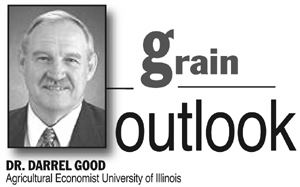|
Corn And Soybean Acreage Questions Persist

Recent USDA reports have left some unresolved questions about the magnitude of planted and harvested acreage of corn and soybeans in 2014. The questions stem from the large differences between the planted acreage estimates from the National Agricultural Statistics Service (NASS) in the November 10 Crop Production report and the planted acreage that has been reported to the Farm Service Agency (FSA) as reflected in the report released on November 13.
The NASS estimate of planted acreage is survey based while FSA acreage data are self-reported by producers. As stated at the FSA website, “Farm Service Agency policy requires that producers participating in several programs submit an annual report regarding all cropland use on their farms. These programs include the direct and counter-cyclical payment program and the Average Crop Revenue Election (ACRE) program. Reporting also applies to those who receive marketing assistance loans or loan deficiency payments. Failure to file an accurate and timely acreage report for all crops and land uses can result in loss of program benefits.” It is not unusual for large differences between NASS and FSA acreage data to exist early in the FSA reporting cycle that begins in August since producer reporting is incomplete, but it is unusual for the large differences to persist in November.
NASS lowered the estimate of planted acreage of corn by 756,000 acres in the October Crop Production report and left the estimate unchanged in the November report. Planted acreage is currently estimated at 90.885 million acres. In the November 13 report, FSA indicated that producers have reported planted acreage of corn of only 85.842 million acres, 5.043 million acres less than the NASS estimate. FSA will release another report of planted acreage on December 15 and a final report of planted acreage in January 2015 based on completed reporting by producers. NASS will release a final estimate of planted acreage in the annual Crop Production report on January 12, 2015. That estimate will reflect data from the large December Agricultural Survey as well as other administrative data, primarily FSA planted acreage estimates. Since NASS uses FSA planted acreage reports as input to its final acreage estimates, the differences between final estimates from the two agencies have historically been relatively constant and much smaller than the current difference of 5.043 million acres.
Planted acreage of corn reported to FSA is less than the NASS acreage estimates since not all producers participate in farm programs that require acreage reporting. From 2007 through 2013, the final difference between the two acreage reports ranged from 2.381 million to 3.221 million acres and averaged 2.798 million acres. Stated differently, acreage reported to FSA ranged from 96.66 percent to 97.45 percent of the NASS estimate and averaged 96.93 percent.
For soybeans, NASS lowered the estimate of planted acres by 655,000 acres in the October Crop Production report and left the estimate unchanged in the November report. Planted acreage is currently estimated at 84.184 million acres. In the November 13 report, FSA indicated that producers have reported planted acreage of soybeans of only 81.392 million acres, 2.792 million acres less than the NASS estimate. Like corn, the differences between final estimates from the two agencies have historically been relatively constant and much smaller than the current difference of 2.792 million acres. From 2007 through 2013, the final difference between the two acreage reports ranged from 917,000 to 1.866 million acres and averaged 1.292 million acres. Acreage reported to FSA ranged from 97.09 percent to 98.79 percent of the NASS estimate and averaged 98.24 percent.
While the large differences between NASS and FSA acreage estimates are very large for this time in the season, the differences will narrow with the December/January reports from the two agencies. How that difference narrows, however, has important price implications for corn and soybeans. Last year, for example, most of the narrowing in the corn estimates was the result of lower NASS estimates. The FSA corn acreage estimates increased by 846,805 acres from September to November and by 76,120 acres from November to January. The NASS planted acreage estimate, however, declined by 2.038 million acres from September to November and increased by only 24,000 acres from November to January. For soybeans the narrowing was the result of almost equal changes in the estimates. The FSA estimate increased by 563,912 acres from September to November and by 76,120 acres from November to January. The NASS planted acreage estimate declined by 685,000 acres from September to November and then increased by 40,000 acres from November to January.
While many suggested that increasing corn futures prices in October reflected the delayed harvest, the increase was likely more the result of the market’s anticipation that the NASS estimate of harvested acreage would ultimately decline. After all, a delayed harvest doesn’t alter the crop size and should have impacted the basis not the price level. The expectation of less acreage was confirmed in the October Crop Production report. The November FSA report suggests that further declines are likely. A small change in either direction seems most likely for soybeans. ∆
DR. DARREL GOOD: Agricultural Economist, University of Illinois
|
|